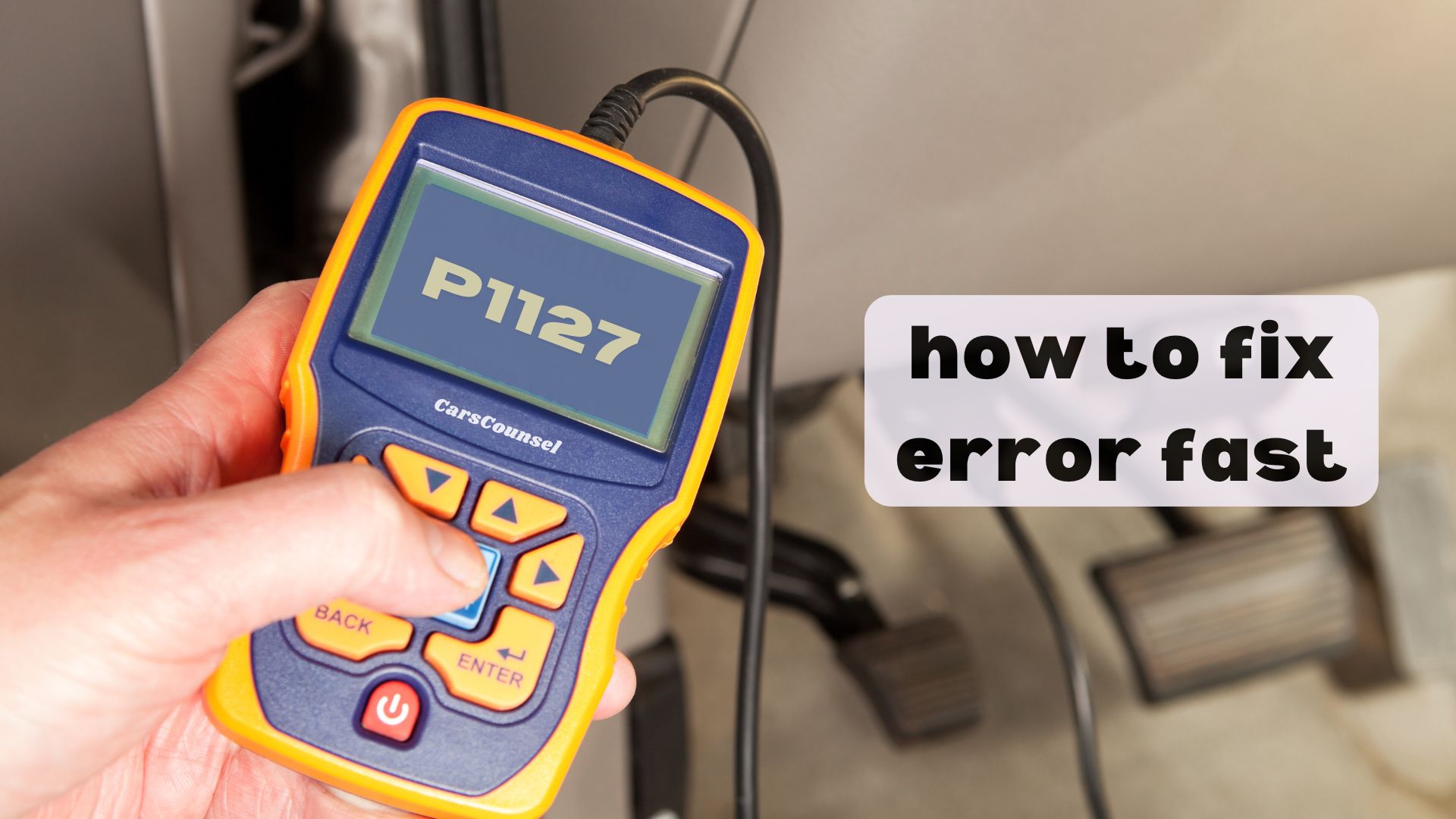When you encounter the P1127 code, it indicates your exhaust system isn’t reaching the necessary temperature, affecting the downstream oxygen sensor’s functionality.
This issue can arise from faulty oxygen sensors, thermostat malfunctions, exhaust leaks, or catalytic converter problems.
As you investigate this error code, you’ll need to evaluate these potential causes and their implications on engine performance and emissions compliance. What steps will you take to diagnose and address this issue?

Quick Navigation
Key Takeaways
- P1127 code indicates the exhaust system is not warming up sufficiently.
- This affects the downstream oxygen sensor’s operation and engine efficiency.
- Common causes include faulty O2 sensors and exhaust leaks.
- Diagnosis involves testing sensors and checking for leaks.
- Ignoring P1127 can lead to reduced fuel efficiency and costly repairs.
Understanding the P1127 Code
Understanding the P1127 code involves recognizing it as an indicator that the exhaust system isn’t reaching the necessary temperature, specifically affecting the downstream oxygen sensor‘s operation.
This issue impacts sensor performance by preventing the downstream sensor from functioning correctly, which can lead to inefficient engine operation.
The P1127 code is triggered when the exhaust temperature fails to meet the required threshold, indicating a potential problem with the exhaust system that needs attention to guarantee ideal engine performance and prevent further issues.
Common Causes and Symptoms
When your vehicle triggers the P1127 code, it indicates that the exhaust system is not warming up sufficiently, which can prevent the downstream oxygen sensor from functioning properly. This affects sensor performance and exhaust temperature, impacting overall engine efficiency.
| Cause | Description | Impact |
|---|---|---|
| Faulty O2 Sensor | Incorrect readings | Poor engine performance |
| Malfunctioning Thermostat | Inconsistent engine temperature | Reduced fuel efficiency |
| Exhaust Leak | Loss of exhaust pressure | Increased emissions risk |
| Catalytic Converter Issues | Reduced exhaust flow | Potential converter damage |
Diagnosis and Troubleshooting
To diagnose and troubleshoot the P1127 code, you’ll need to focus on identifying why your exhaust system isn’t warming up sufficiently.
Use diagnostic techniques like sensor testing to check the downstream oxygen sensor’s operation. Make certain there are no exhaust leaks and verify the catalytic converter’s condition.
Additionally, inspect the thermostat for proper function, as it affects engine temperature. These steps will help pinpoint the root cause of the issue, guiding you toward the appropriate repair.
Repair Options and Estimates
Repairing the P1127 code involves addressing several potential issues, each with its own cost implications. You’ll need to evaluate repair techniques and conduct a cost analysis to determine the best course of action.
| Issue | Repair Cost | Description |
|---|---|---|
| Oxygen Sensor | $200-$300 | Replace faulty sensor |
| Thermostat | $150-$250 | Verify proper engine temperature |
| Exhaust Leak | $500-$1500+ | Seal leaks to prevent damage |
| Catalytic Converter | Varies | Potential damage if not addressed |
| Consultation | Varies | Essential for accurate diagnosis |
Potential Risks and Consequences
Ignoring the P1127 code can lead to several potential risks and consequences.
If the exhaust remains too cool, it may affect engine performance by preventing ideal combustion, leading to reduced fuel efficiency and increased emissions.
This can strain the emissions control system, potentially causing damage to the catalytic converter over time.
Failing to address these issues promptly can result in costly repairs and decreased vehicle reliability.
It’s essential to diagnose and fix the underlying causes to maintain peak engine performance and emissions control.
Tools and Resources for Repair
When tackling the P1127 code, you’ll need a range of tools and resources to effectively diagnose and fix the issue.
Essential repair tools include an OBD-II scanner for code retrieval and a multimeter for voltage checks.
Online resources can provide detailed repair guides and troubleshooting tips.
Here are some key resources to evaluate:
- Factory Service Manuals: Detailed instructions for specific vehicle models.
- OBD-II Code Search Platforms: AI-driven solutions for diagnosing and repairing codes.
- Online Forums: Community-driven discussions for troubleshooting and repair advice.
Step-by-Step Repair Guide
To tackle the P1127 code effectively, you’ll need to follow a structured approach that involves diagnosing the root cause and then applying the appropriate fix.
Start by inspecting the exhaust system for leaks, which can prevent the downstream oxygen sensor from reaching ideal temperature. Check the oxygen sensor itself for faults and consider replacing it if necessary.
Next, inspect the thermostat and catalytic converter for any issues. Once the cause is identified, proceed with the necessary repairs to guarantee the exhaust system operates efficiently and safely.
Prevention and Maintenance Tips
Preventing the P1127 code from occurring involves regular maintenance and inspections of your vehicle’s exhaust system. You can take several preventive measures to guarantee peak performance:
- Monitor Oxygen Sensors: Regularly check and replace oxygen sensors to prevent faulty readings.
- Inspect Exhaust System: Look for leaks or damage in the exhaust system to maintain proper exhaust flow.
- Check Thermostat Function: Verify the thermostat operates correctly to sustain ideal engine temperature.
Regular maintenance helps prevent issues that lead to the P1127 code.
More OBD-II Codes
| P1128 | P1129 | P1130 | P1132 |
| P1133 | P1134 | P1136 | P1135 |
| P1147 | P1148 | P1149 | P1150 |
| P1032 | P1153 | P1154 | P1336 |
| P1352 | P1361 | P1362 | P1380 |
| P1381 | P1404 | P1441 | P1546 |
Frequently Asked Questions
Can P1127 Affect Vehicle Performance?
You’ll notice that P1127 can affect engine performance by impacting sensor calibration, potentially leading to inefficient combustion and reduced engine efficiency. This can result in decreased fuel efficiency and overall vehicle performance.
Is P1127 Specific to Certain Vehicles?
You’ll encounter the P1127 code across various vehicle models, not just one specific type. It’s essential to use P1127 diagnostic tools to identify the issue in your vehicle, as causes can vary widely.
Can I Drive With the P1127 Code?
You can drive with the P1127 code, but it may affect performance and fuel efficiency. Use diagnostic tools to assess sensor calibration and potential issues before proceeding.
Does P1127 Indicate a Faulty Catalytic Converter?
You’re diagnosing whether P1127 indicates a faulty catalytic converter. While it doesn’t directly point to catalytic converter symptoms, it can be related to exhaust system diagnostics, potentially affecting the converter’s performance.
Can DIY Fixes Resolve P1127 Issues?
You can resolve some P1127 issues with DIY fixes, such as using diagnostic tools to identify problems and performing sensor replacement if necessary. However, more complex issues like exhaust leaks may require professional assistance.
Conclusion
You’ve addressed the P1127 code, understanding its causes and implications. Now, will you let a faulty exhaust system compromise your engine’s performance and emissions compliance? Timely repairs are essential to prevent damage and maintain efficiency. Make certain you diagnose and fix issues promptly to avoid long-term consequences. Regular maintenance can also help prevent such problems from arising in the future.

